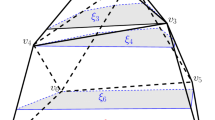Abstract
We investigate three-dimensional visibility problems in which the viewing position moves along a straight flightpath. Specifically we focus on two problems: determining the points along the flightpath at which the topology of the viewed scene changes, and answering ray-shooting queries for rays with origin on the flightpath. Three progressively more specialized problems are considered: general scenes, terrains, and terrains with vertical flightpaths.
Similar content being viewed by others
References
K. Abrahamson, N. Dadoun, D. K. Kirkpatrick, and T. Przytycka, A simple parallel tree contraction algorithm,Proc. 25th Annual Allerton Conf. on Communications, Control, and Computing, 1987, pp. 624–633.
P. K. Agarwal,Intersection and Decomposition Algorithms for Planar Arrangements, Cambridge University Press, Cambridge, 1991.
M. J. Atallah, Some dynamic computational geometry problems,Comput. Math. Appl. 11 (1985), 1171–1181.
J. L. Bentley and T. A. Ottmann, Algorithms for reporting and counting geometric intersections,IEEE Trans. Comput. 28 (1979), 643–647.
R. Cole and M. Sharir, Visibility problems for polyhedral terrains,J. Symbolic Comput. 7 (1989), 11–30.
J. R. Driscoll, N. Sarnak, D. Sleator, and R. E. Tarjan, Making data structures persistent,J. Comput. Systems Sci. 38 (1989), 86–124.
H. Edelsbrunner, J. O'Rourke, and R. Seidel, Constructing arrangements of lines and hyper- planes with applications,SIAM J. Comput. 15 (1986), 341–363.
H. Fuchs, Z. M. Kedem, and B. F. Naylor, On visible surface generation bya priori tree structures,Comput. Graphics 14 (1980), 124–133.
S. Hart and M. Sharir, Nonlinearity of Davenport-Schinzel sequences and of generalized path compression schemes,Combinatorica 6 (1986), 151–177.
J. Hershberger, Finding the upper envelope ofn line segments in O(n logn) time,Inform. Process. Lett. 33 (1989), 169–174.
H. Hubschman and S. Zucker, Frame-to-frame coherence and the hidden surface computation: constraints for a convex world,Comput. Graphics 15 (1981), 45–54.
J. W. Jaromczyk and M. Kowaluk, Skewed projections with an application to line stabbing in R3,Proc. 4th ACM Symp. on Computational Geometry, 1988, pp. 362–370.
S. R. Kosaraju and A. L. Delcher, Optimal parallel evaluation of tree-structured computation by ranking,VLSI Algorithms and Architectures: Proc. 3rd Aegean Workshop on Computing, 1988, pp. 101–110.
D. T. Lee and F. P. Preparata, Location of a point in a planar subdivision and its applications,SIAM J. Comput. 6 (1977), 594–606.
M. McKenna, Worst-case optimal hidden surface removal,ACM Trans. Graphics 6 (1987), 19–28.
G. L. Miller and J. H. Reif, Parallel tree contraction and its applications,Proc. 26th IEEE Foundations of Computer Science, 1985, pp. 478–489.
K. Mulmuley, A fast planar partition algorithm,I,Proc. 29th IEEE Foundations of Computer Science, 1988, pp. 580–589.
K. Mulmuley, On obstructions in relation to a fixed viewpoint,Proc. 30th IEEE Foundations of Computer Science, 1989, pp. 592–597.
K. Mulmuley, Hidden surface removal with respect to a moving view point,Proc. 23rd ACM Symp. on Theory of Computing, 1991, pp. 512–522.
M. Overmars and M. Sharir, A simple output-sensitive algorithm for hidden surface removal,ACM Trans. Graphics 11 (1992), 1–11.
M. Paterson and F. F. Yao, Binary partitions with applications to hidden surface removal and solid modelling,Discrete Comput. Geom. 5 (1990), 485–504.
W. H. Plantinga and C. R. Dyer, Visibility, occlusion, and the aspect graph,Internat. J. Comput. Vision,5 (1990), 137–160.
W. H. Plantinga, C. R. Dyer, and B. Seales, Real-time hidden-line elimination for a rotating polyhedral scene using the aspect representation, Manuscript, 1988.
F. P. Preparata and M. I. Shamos,Computational Geometry: An Introduction, Springer-Verlag, New York, 1985.
F. P. Preparata and R. Tamassia, Fully dynamic point location in a monotone subdivision,SIAM J. Comput. 18 (1989), 811–830.
J. H. Reif and S. Sen, An efficient output-sensitive hidden-surface removal algorithm and its parallelization,Proc. 4th ACM Symp. on Computational Geometry, 1988, pp. 194–200.
M. Sharir, Almost linear upper bounds on the length of general Davenport-Schinzel sequences,Combinatorica 7 (1987), 131–143.
I. E. Sutherland, R. F. Sproull, and R. A. Schumacker, A characterization of ten hidden-surface algorithms,Comput. Surveys 6 (1974), 1–25.
G. R. Swart, A schema for real time hidden line removal, Technical Report, Department of Computer Science, University of Washington, 1984.
A. Wiernik and M. Sharir, Planar realization of nonlinear Davenport-Schinzel sequences by segments,Discrete Comput. Geom. 3 (1988), 15–47.
Author information
Authors and Affiliations
Additional information
Communicated by Bernard Chazelle.
Supported in part by NSF Grant CCR87-00917 and a Guggenheim Fellowship. Work done while visiting Xerox PARC.
Work done while at Xerox PARC.
Work done while visiting Xerox PARC.
Rights and permissions
About this article
Cite this article
Bern, M., Dobkin, D., Eppstein, D. et al. Visibility with a moving point of view. Algorithmica 11, 360–378 (1994). https://doi.org/10.1007/BF01187019
Received:
Revised:
Issue Date:
DOI: https://doi.org/10.1007/BF01187019




